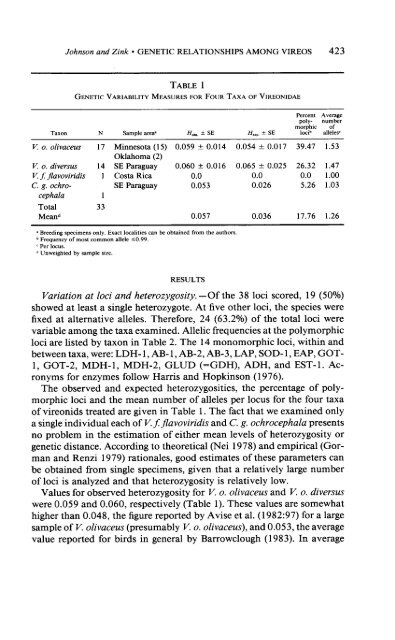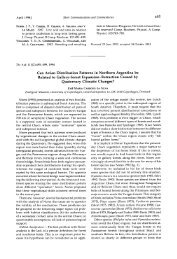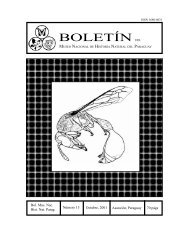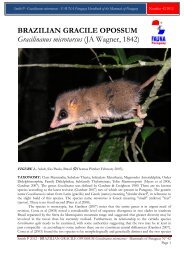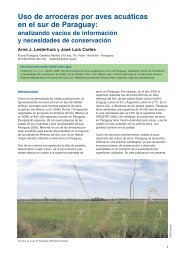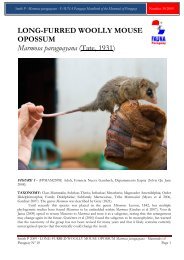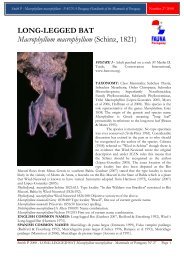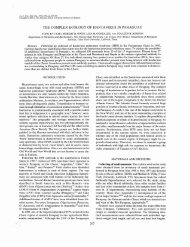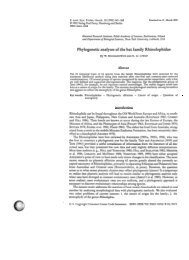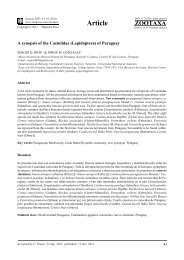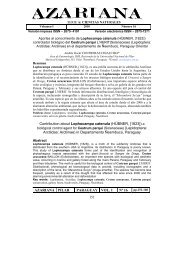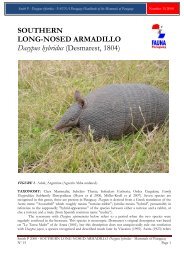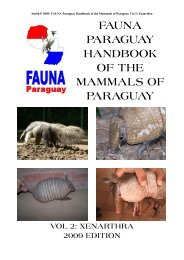Download pdf 838KB - FAUNA Paraguay
Download pdf 838KB - FAUNA Paraguay
Download pdf 838KB - FAUNA Paraguay
Create successful ePaper yourself
Turn your PDF publications into a flip-book with our unique Google optimized e-Paper software.
Johnson and Zink l GENETIC RELATIONSHIPS AMONG VIREOS 423<br />
TABLE 1<br />
GENETIC VARIABILITYMEASURESFOR FOUR TAXAOFVIREONIDAE<br />
Percent Average<br />
PolY- number<br />
morphic of<br />
TaXOIl N Sample areas H., k SE H.,. k SE locib all&S=<br />
V. 0. olivaceus 17 Minnesota (15) 0.059 + 0.014 0.054 k 0.017 39.47 1.53<br />
Oklahoma (2)<br />
V. o. diversus 14 SE <strong>Paraguay</strong> 0.060 + 0.016 0.065 2 0.025 26.32 1.47<br />
V. J jlavoviridis 1 Costa Rica 0.0 0.0 0.0 1.00<br />
C. ochro-<br />
g. SE <strong>Paraguay</strong> 0.053 0.026 5.26 1.03<br />
cephala 1<br />
Total 33<br />
Meand 0.057 0.036 17.76 1.26<br />
= Breeding specimens only. Exact localities can be obtained from the authors<br />
b Frequency of most common allele 50.99.<br />
c Per locus.<br />
d Unweighted by sample size.<br />
RESULTS<br />
Variation at loci and heterozygosity. -Of the 38 loci scored, 19 (50%)<br />
showed at least a single heterozygote. At five other loci, the species were<br />
fixed at alternative alleles. Therefore, 24 (63.2%) of the total loci were<br />
variable among the taxa examined. Allelic frequencies at the polymorphic<br />
loci are listed by taxon in Table 2. The 14 monomorphic loci, within and<br />
between taxa, were: LDH- 1, AB- 1, AB-2, AB-3, LAP, SOD- 1, EAP, GOT-<br />
1, GOT-2, MDH-1, MDH-2, GLUD (=GDH), ADH, and EST-l. Acronyms<br />
for enzymes follow Harris and Hopkinson (1976).<br />
The observed and expected heterozygosities, the percentage of polymorphic<br />
loci and the mean number of alleles per locus for the four taxa<br />
of vireonids treated are given in Table 1. The fact that we examined only<br />
a single individual each of V. Jflavoviridis and C. g. ochrocephala presents<br />
no problem in the estimation of either mean levels of heterozygosity or<br />
genetic distance. According to theoretical (Nei 1978) and empirical (Gorman<br />
and Renzi 1979) rationales, good estimates of these parameters can<br />
be obtained from single specimens, given that a relatively large number<br />
of loci is analyzed and that heterozygosity is relatively low.<br />
Values for observed heterozygosity for V. o. olivaceus and V. o. diversus<br />
were 0.059 and 0.060, respectively (Table 1). These values are somewhat<br />
higher than 0.048, the figure reported by Avise et al. (1982:97) for a large<br />
sample of V. olivaceus (presumably V. o. olivuceus), and 0.053, the average<br />
value reported for birds in general by Barrowclough (1983). In average


